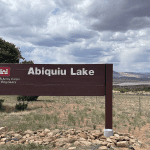- The Navajo Nation is urging Congress to pass the Northeastern Arizona Indian Water Rights Settlement Act, which resolves decades-long water rights claims for the Navajo Nation, Hopi Tribe, and San Juan Southern Paiute Tribe.
- The settlement allocates Arizona’s 50,000 acre-feet of Upper Basin water.
- The agreement addresses historical inequities in water allocation and marks progress toward promises made nearly 80 years ago during negotiations prioritizing Arizona’s Central Arizona Project over tribal water needs.
December 18, 2024 — The Navajo Nation is making a last-minute appeal for Congressional approval of the Northeastern Arizona Indian Water Rights Settlement Act, which would settle the water right claims of the Navajo Nation and Hopi Tribe and establish Tribal lands and water for the San Juan Southern Paiute Tribe.
In a Colorado Sun article outlining the settlement and the Navajos’ hope, journalist Shannon Mullane writes, “Congress is set to be adjourned by Friday, and federal lawmakers want to see a consensus from all seven Colorado River Basin states before voting. If that doesn’t happen, advocates would have to restart with a new mix of federal lawmakers next year.”
outlining the settlement and the Navajos’ hope, journalist Shannon Mullane writes, “Congress is set to be adjourned by Friday, and federal lawmakers want to see a consensus from all seven Colorado River Basin states before voting. If that doesn’t happen, advocates would have to restart with a new mix of federal lawmakers next year.”
As Mullane notes, the Navajo Nation spans both the Upper and Lower Colorado River Basins . The Upper Basin states — Colorado, Utah, New Mexico and Wyoming –have concerns about how water from their basin will be used downstream.
. The Upper Basin states — Colorado, Utah, New Mexico and Wyoming –have concerns about how water from their basin will be used downstream.
John Flek at Inkstain writes that the settlement allocates Arizona’s 50,000 acre-feet of Upper Basin water—originally intended for Native American use, as acknowledged during 1949 Congressional hearings. According to Fleck
writes that the settlement allocates Arizona’s 50,000 acre-feet of Upper Basin water—originally intended for Native American use, as acknowledged during 1949 Congressional hearings. According to Fleck , the backstory reveals that Arizona negotiated this allocation in 1948, prioritizing its Central Arizona Project (CAP) over tribal water needs. Arizona accepted a reduced allotment of 50,000 acre-feet to secure support for CAP’s Congressional approval while leveraging “stream depletion theory” to maximize water usage. Despite the CAP’s completion in the 1990s, tribal water rights remained unresolved. The Northeastern Arizona Indian Water Rights Settlement is a significant step toward fulfilling promises made nearly eight decades ago.
, the backstory reveals that Arizona negotiated this allocation in 1948, prioritizing its Central Arizona Project (CAP) over tribal water needs. Arizona accepted a reduced allotment of 50,000 acre-feet to secure support for CAP’s Congressional approval while leveraging “stream depletion theory” to maximize water usage. Despite the CAP’s completion in the 1990s, tribal water rights remained unresolved. The Northeastern Arizona Indian Water Rights Settlement is a significant step toward fulfilling promises made nearly eight decades ago.
~~~
Image:
Stone house and landscape of the Hopi village of Oraibi , in northern Arizona. 2010, by Promking. Released into the public domain.
, in northern Arizona. 2010, by Promking. Released into the public domain.




Leave a Reply